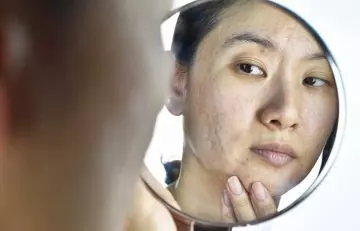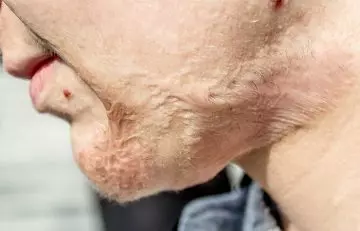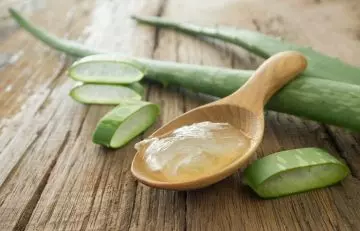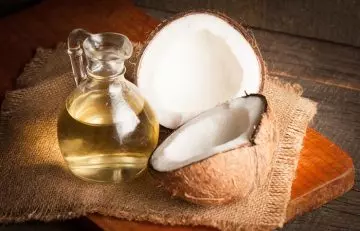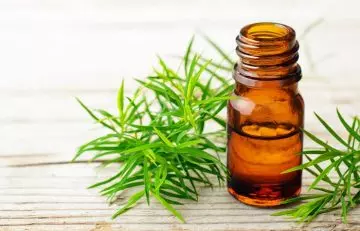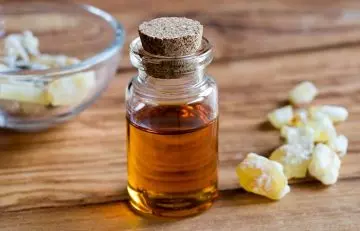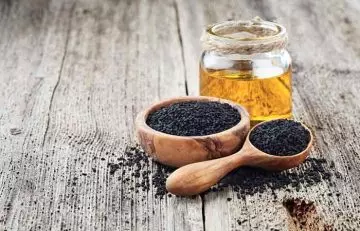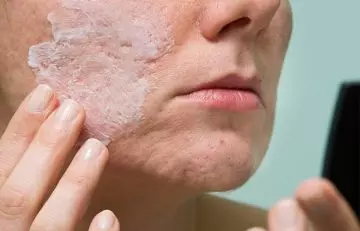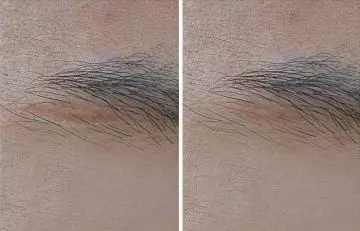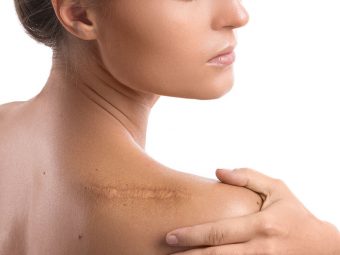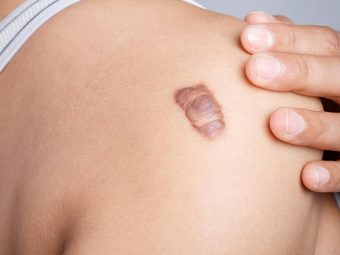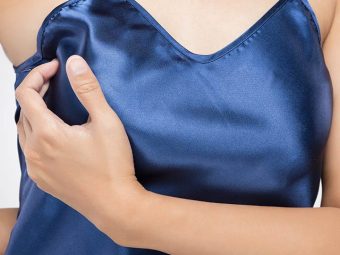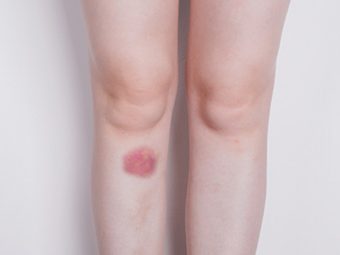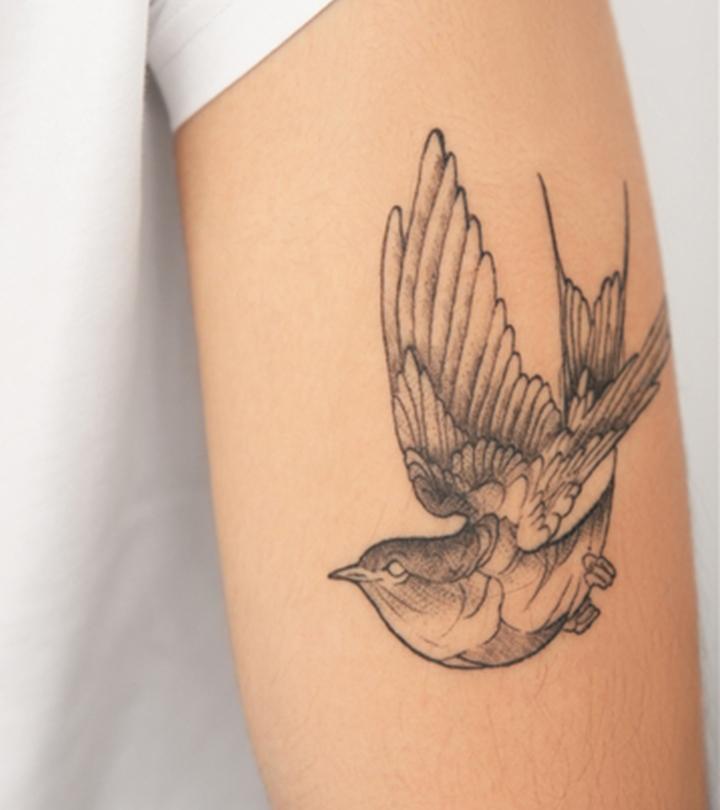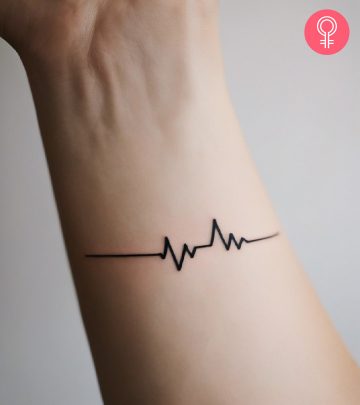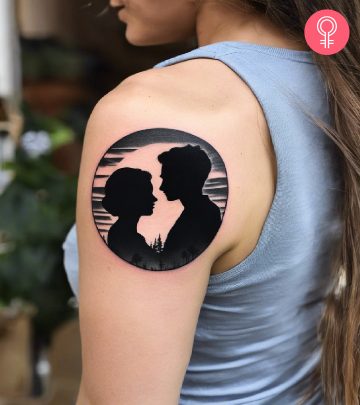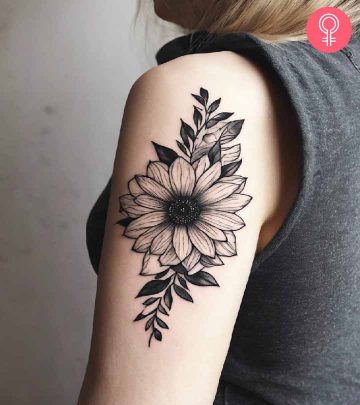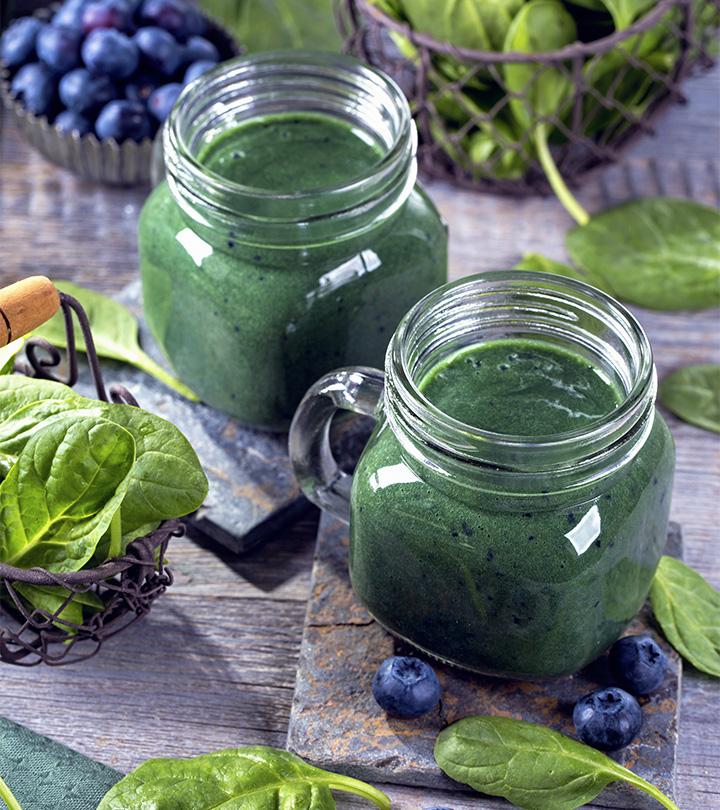11 Best Home Remedies To Get Rid Of Facial Scars Naturally
From home remedies to medical treatments, there are many ways to get rid of those marks on your face.

Image: Shutterstock
Not everyone may feel comfortable embracing the scars, especially on the face. So, if you are wondering how to get rid of scars on your face naturally, let us tell you that they won’t disappear completely. However, these remedies may help fade them and minimize their appearance. We have compiled a list of the 11best home remedies that can help heal scars on the face over time. But first, let’s look at the science behind scars. Keep scrolling!
In This Article
Scars: What Are They And What Are Their Types?
A scar is proof that your skin is healing. Your skin develops a scar following an injury. The skin has three layers – the epidermis (the topmost layer), the dermis, and the hypodermis. When the dermis is damaged, your body tries to heal itself. It starts forming collagen fibers to repair the damage, leaving behind a scar.
An internet survey study from April-May 2020 with 11,100 participants shows the psychosocial impact of visible scars. 48.5% of the respondents reported having a scar that was less than a year old. The average Dermatology Life Quality Index (DLQI) was 7.44, which showed a decrease to 2.90 after a year. 33.9% of participants with scars less than 3 months old reported a more negative impact on quality of life than 10.2% of participants with scars aged 12 months or older.
How Do Scars Form?
The scar’s severity depends on the severity of your wound and how fast it heals. In most cases, if it’s a small wound and if it heals fast, there will be less collagen deposit on the wound area. As a result, the scar will not be noticeable. However, depending on the area of your body and age, scars may form differently. Each type of scar has different characteristics. Let’s take a look.
Different Types Of Scars
Depending on the rate at which your body heals, scars can be of the following types:
1. Atrophic Scars
These scars are formed when your skin is unable to regenerate tissues, which causes imbalanced scarring. They often look like sunken areas on the skin. The best examples of atrophic scars are scars caused by acne and chicken pox.
2. Keloid Scars
Keloid scars are caused by overproduction of tissues on the wound site. They are raised, puffy, and darker than the surrounding skin. Keloid scars often go beyond the original injury site and can also hamper movement. They are most common in people with darker skin tones.
3. Hypertrophic Scars
These are somewhat similar to keloid scars, but unlike them, these scars do not go beyond the site of injury. Hypertrophic scars are formed when there is an overproduction of tissues on the site of injury as the skin heals. These also have a dark appearance.
4. Contracture Scars
These scars develop when your skin is recovering from a burn. Contracture scars tighten the skin and can restrict your movement. These scars may also go deeper and affect your nerves and muscles.
You may also get scars from scratches, bites, pregnancy (stretch marks), and injuries caused by self-harm. Let us take a closer look at some of the medical treatments you can use to improve the appearance of scars.
Medical Remedies For Getting Rid Of Scars
1. Laser Therapy
It is also known as laser scar revision, where laser beams are used to remove the topmost layer of the scar. It also targets the blood vessels in the specific area to reduce inflammation and improve the appearance of the scar.
2. Microneedling
This minimally invasive procedure involves pricking the scars with tiny needles or a dermaroller to create micro wounds. Dermarolling boosts collagen production in the area and improves scar appearance. A study found that microneedlingi XA minimally invasive cosmetic procedure that involves pricking the skin with needles to stimulate collagen production could improve scar appearance by 31 to 62% (1).
3. Dermal Fillers
Dermal fillers use hyaluronic acid or other gel-like substances to raise the pitted scars caused by acne. You can either opt for temporary fillers or more permanent fillers to improve the appearance of the scars. Consult a dermatologist to understand the benefits and risks of the procedure before opting for it.
4. Subcision
Subcision is a minor surgical procedure where a small needle is used to puncture the scar and break the fibrous tissues connecting the scar with the underlying tissues. As the wound heals, the new collagen formation improves the appearance of the scars. It is considered one of the safest and most effective methods for treating acne scars (2).
There are other medical treatments you can consider such as using topical scar creams, microdermabrasion (removes surface skin wrinkles and scars), dermabrasion (more aggressive but effective results), and platelet-rich plasma (PRP) therapy. Your doctor may prescribe serums containing niacinamide or retinoids like tretinoin to reduce scar appearance.
While deep scars may not fade easily, if you have scars on the face caused by acne, chickenpox, or a small wound, you may try these home remedies to reduce their appearance.
 Quick Tip
Quick TipTop 11 Home Remedies For Scars On Face
1. Aloe Vera
A study found that topical application of aloe vera could heal cutaneous wounds in rats (3). It modulated the inflammation and decreased scar tissue size. Also, it contains vitamin C, vitamin A, and vitamin E, which have antioxidant properties and may boost skin health.
You Will Need
1 tablespoon of fresh aloe vera gel
Method
- Extract clear aloe vera gel from the leaf.
- Apply it directly on the scars in a circular motion.
- Leave it on for half an hour and then wash it off.
- Repeat two times daily.
A blogger observed noticeable results after a week of applying aloe vera gel on her skin: “My larger breakout areas completely smoothed out and the redness was minimized. A few blemishes [were] also banished [sic] within a week of using aloe vera, mainly in the temple area (i).”
2. Honey
Honey was found to promote healing and prevent excessive scarring (4). Honey can be used for all types of wounds, including cuts and burns.
You Will Need
1 tablespoon of organic or Manuka honey (adjust the quantity as required)
Method
- Apply honey to the wound before going to bed.
- Wrap the area with a bandage. Let it stay overnight.
- Remove the bandage and wash the area the next morning.
- Repeat this every day
3. Coconut Oil
Although no studies show the effectiveness of coconut oil in fading scars, one study found that applying virgin coconut oil to dermal wounds could accelerate healing (5). It promotes collagen development and speeds up the healing process, reducing the chances of scarring.
You Will Need
1 tablespoon of virgin coconut oil
Method
- Massage the coconut oil on the affected area for about 20 minutes.
- Let your skin soak it up for about an hour.
- You may wash it off later or leave it on.
- Repeat the process 2-3 times every day.
4. Apple Cider Vinegar
Apple cider vinegar contains lactic and acetic acids (6). These acids are often used in chemical peels to fade acne scars (7). Applying ACV on scars may exfoliate the area and improve the appearance of the scars.
You Will Need
- 2 tablespoons of ACV
- 4 tablespoons of distilled water
Method
- Combine the two ingredients.
- Dip a cotton ball into the mixture and dab it on your scars.
- Leave it on overnight.
- Repeat this every day.
5. Rosehip Seed Oil
This is probably the ultimate BFF your skin can ever have! Rosehip seed oil not only helps alleviate skin issues and keeps your skin glowing but also improves the appearance of scars and wrinkles. A study found that it also works great on improving post-surgical scars (8).
You Will Need
A few drops of rosehip seed oil
Method
- Use a dropper to apply a few drops of rosehip oil to the affected area.
- Massage it gently for a few minutes.
- Leave it on overnight and wash it off the next day.
- Repeat every night.
6. Helichrysum Essential Oil
Helichrysum essential oil prevents the formation of collagen III and inhibits tissue remodeling-related molecules (9). This promotes wound healing and aids the development of tissues, without the formation of a scar.
You Will Need
- 10 drops helichrysum oil
- 1 tablespoon rosehip seed oil
Method
- Mix both the oils in a bowl.
- Store it in a dark glass bottle.
- Apply a few drops of the mixture to the scar.
- Leave it on for a few hours and then wash off. You may leave it overnight if you want.
- Use it twice daily.
7. Tea Tree Oil
Tea tree oil has anti-inflammatory and antibacterial properties and is widely used for treating acne. A study found that the combination of tea tree oil and aloe vera could reduce scarring caused by erythema (8).
You Will Need
- 12 drops of pure tea tree essential oil
- 2 tablespoons of pure aloe vera gel
- ½ teaspoon of rosehip seed oil or jojoba oil
Method
- Mix ingredients in a bowl.
- Apply on the scars before going to bed. Leave it on overnight.
- Wash with lukewarm water the next day.
- Repeat this every night.
8. Olive Oil And Eucalyptus Oil
According to research, a combination of olive oil and eucalyptus oil speeds up wound healing by supporting healthy tissue formation (11). This prevents scarring.
You Will Need
- 3 drops of eucalyptus oil
- 2 tablespoons of olive oil
Method
- Mix both the oils and store the blend in a dark glass bottle.
- Take a few drops of the oil mixture and massage it onto the affected area for 5 minutes.
- Leave it on for a few hours and then wash with warm water.
9. Frankincense Essential Oil
Studies show that frankincense essential oil has wound healing properties and improves the appearance of scars by lowering the levels of collagen III in the scar tissue (12), (13).
You Will Need
- 2 tablespoons of any carrier oil (you may use rosehip seed, jojoba, or apricot oils)
- 3-4 drops of frankincense oil
Method
- Mix frankincense oil with a carrier oil of your choice. Shake well to mix.
- Massage a few drops of the oil blend on the scar. Leave it on overnight.
- Wash it off the next morning.
- Repeat every night.
10. Clary Sage Essential Oil
Clary sage has antibacterial properties that promote faster wound healing. It can kill Staphylococcus bacteria and promotes healthy wound healing (14). This, in turn, prevents scar formation.
You Will Need
- 2 tablespoons of jojoba oil
- 4 drops of tea tree oil
- 4 drops of clary sage oil
Method
- Mix all the oils and store in a dark glass bottle.
- Massage the oil on your scars. Leave it on for a few hours.
- Wash it off.
- Repeat this twice daily.
11. Black Seed Oil
Black seed oil’s anti-inflammatory, antibacterial, and antioxidant properties may promote skin healing and regeneration. This way, the oil may reduce the chances of scarring (15).
You Will Need
- 1-2 drops of black seed oil
- A carrier oil, like coconut oil or almond oil
Method
- Dilute 1-2 drops of black seed oil with the carrier oil.
- Perform a patch test by applying a small amount to your forearm to check for any adverse reactions.
- You can proceed to apply the mixture to your facial scars if no irritation occurs.
- Gently massage the oil onto the scars using your fingertips.
- Leave it on for at least 30 minutes or overnight.
- Rinse with warm water.
- You can use this treatment daily or as needed.
 Quick Tip
Quick TipApart from these natural remedies, you may try noninvasive treatments at home. They often help in improving the appearance of scars.
Noninvasive Treatment Options For Scars At Home
1. Silicone Gel Sheeting
Silicone sheeting is probably the most effective of all noninvasive home remedies for scars. It is a proven way to minimize the appearance of abnormal scars (16). Silicone sheets are available in medical stores and are beneficial in improving the appearance of post-surgical scars. These sheetings have low side effects and are painless and easy to use.
2. Pressure Garments
Pressure garments are usually worn after a burn to manage scarring. Pressure garments put direct pressure on the skin. Before wearing pressure garments, the healed skin is preconditioned to take on the pressure and stress. This garment is extremely helpful in reducing scars. However, it is up to the doctor to decide how long you need to wear them.
3. Chemical Exfoliators
Chemical exfoliants such as glycolic acid, salicylic acid, and AHA peels help smooth fine lines and wrinkles and improve the appearance of many types of scars and marks. Mostly, the peels are beneficial in improving the appearance of acne scars. You may try applying low-strength peels at home. However, for a stronger peel (with a high acid concentration), you must consult a doctor first.
You can also try applying scar camouflage makeup to conceal scars, blemishes, and spots.
These are the measures to minimize the appearance of scars much after the wound has healed completely. However, if you are conscious and careful, you can prevent scarring while the wound is healing. Here are a few points to keep in mind.
 Did You Know?
Did You Know?How To Prevent Scars On The Face And Other Body Parts
The American Academy of Dermatology recommends proper wound care to avoid scars(18). Here are a few points that they recommend:
1. Keep The Site Of Injury Clean
Use a mild soap and water to keep the injury site clean. This keeps away germs and also removes the debris.
2. Keep The Wound Moist
Use petroleum jelly on the injury site to keep it moist. Petroleum jelly prevents moisture loss and prevents scab formation. Wounds with scabs take a long time to heal. Also, keeping the area moist prevents itchiness caused by the drying wound. It also prevents the development of deep and large scars.
3. Remove The Stitches On Time
Do not wait for too long to remove your stitches as it can interfere with the healing process and cause scarring. Follow your doctor’s advice and remove them in time. Also, don’t try to take the stitches off too early.
4. Use SPF And Protective Clothing
UV rays can enhance the appearance of the scars or even cause darkening of the affected area. During the healing period, don’t forget to use SPF and clothes that help with sun protection.
Infographic: Best Treatments And Home Remedies For Facial Scars
Noticeable facial scars draw attention and cause social anxiety and a lack of confidence, which is why they should be treated. Thanks to the advancement of science and the use of age-old remedies, these scars aren’t difficult to lighten. Check out the infographic below to find the best possible home and medical treatments for treating facial scars. Illustration: StyleCraze Design Team
Conclusion
It is impossible to remove facial scars with home remedies, especially if they are old scars. And that is why you must focus on proper wound care to facilitate skin healing and minimize the risk of deep scarring. You may follow the recipes discussed in the article to care for the wound and heal scars.
However, if you want to know how to get rid of or fade scars on your face, it is best to consult a doctor and go for cosmetic procedures. This can help improve their appearance greatly and make your skin appear even. However, discuss the risk factors beforehand to avoid side effects.
Frequently Asked Questions
Does vitamin E work for facial scars?
No. Studies found that topical vitamin E has no positive effect on scars but could worsen the appearance of scars (19).
Can lemon work for facial scars?
Yes, lemon juice may help reduce the appearance of facial scars, especially those caused by acne. However, you should know your skin type and do a patch test to avoid any rash or sensitivity.
How long does a scar take to fade?
It may take between 6 months to 2 years for a scar to fade. However, the scar may not go away permanently.
Why do scars turn dark?
Your scar may become dark due to the overproduction of melanin, the pigment responsible for your skin color. This is also known as hyperpigmentation.
Can baking soda remove scars?
No evidence suggests that baking soda can fade the appearance of scars. However, it is abrasive and may exfoliate the skin, improving the scar’s appearance to some extent.
Key Takeaways
- Apply aloe vera gel to your scar. It helps relieve inflammation and decrease the size of the scar tissue.
- Try using apple cider vinegar; it is a gentle exfoliant that can fade dark spots.
- You can also use tea tree oil to reduce acne marks on your skin.
- Use a silicon gel sheet to reduce the appearance of deep scars resulted from surgeries.

Image: Stable Diffusion/StyleCraze Design Team
Unlock the secrets to remove the scars on your face! Dive into this insightful video that reveals effective methods and tips for reducing the appearance of scars and achieving a flawless skin texture.
Personal Experience: Source
StyleCraze's articles are interwoven with authentic personal narratives that provide depth and resonance to our content. Below are the sources of the personal accounts referenced in this article.
i. CAN ALOE VERA CLEAR HORMONAL ACNE/SCARS IN 1 WEEK?https://the-dailycatchup.blogspot.com/2018/06/can-aloe-vera-clear-hormonal-acnescars.html
References
Articles on StyleCraze are backed by verified information from peer-reviewed and academic research papers, reputed organizations, research institutions, and medical associations to ensure accuracy and relevance. Read our editorial policy to learn more.
- “A systematic review of treatments.” US National Library of Medicine
- “Subcision for Acne Scarring.” Dermatologic Surgery
- “Topical application of Aloe Vera..” US National Library of Medicine.
- “Wound healing activity..” AYU, US National Library of Medicine.
- “Effect of topical application of virgin coconut..” Skin Pharmacology and Physiology, US National Library of Medicine.
- “Diversity of the microbiota..” International Journal of Food Microbiology, US National Library of Medicine.
- Chemical Peels for acne.., Journal of Cutaneous and Aesthetic Surgery, US National Library of Medicine.
- Evolution of Post-Surgical.., Journal of Cosmetics, Dermatological Sciences and Application, Science Research Publishing.
- Chemical composition analysis..” Biochimie Open, US National Library of Medicine.
- “Treatment of acne with a combination..” Clinical Pharmacology:Advances and Application.
- “Essential oil-loaded..” International Journal of Nanomedicine, US National Library of Medicine.
- “Biological activities of ..” Biochimie Open, ScienceDirect.
- “Commercial Essential oils..” Evidence-based Complementary and Alternative Medicine, US National Library of Medicine.
- “The effect of clary sage..” International Journal Of Cosmetic Science
- “Nigella sativa and Its Active Compound, Thymoquinone, Accelerate Wound Healing in an In Vivo Animal Model: A Comprehensive Review” Int J Environ Res Public Health, US National Library of Medicine.
- “International clinical..” Plastic and Reconstructive Surgery.
- “Therapeutic Agents And Herbs In Topical Application For Acne Treatment” Advances in Dermatology and Allergology, US National Library of Medicine.
- “Proper wound care..” American Academy of Dermatology.
- “ The effects of topical vitamin E on the cosmetic appearance of scars” Dermatologic Surgery.





